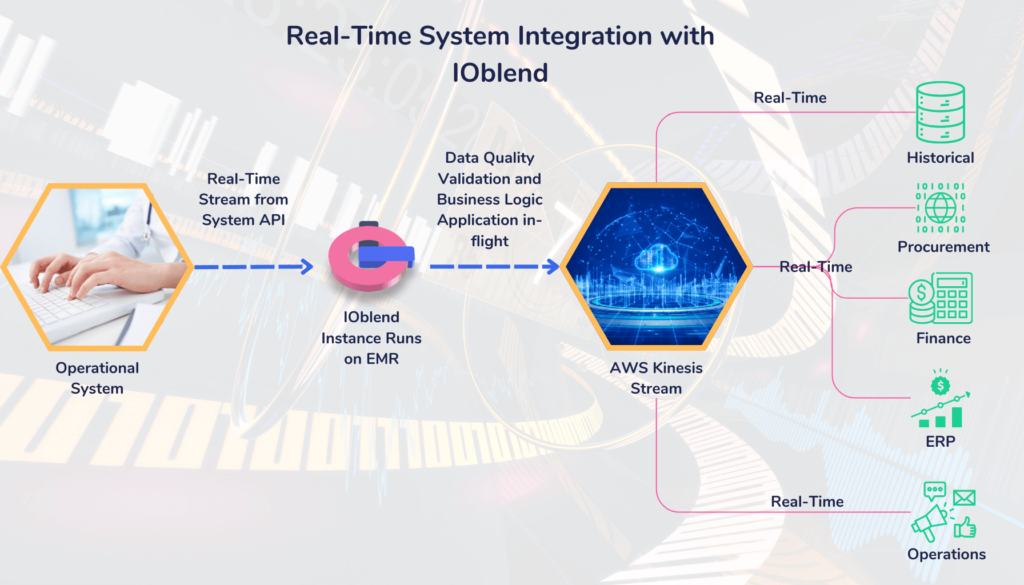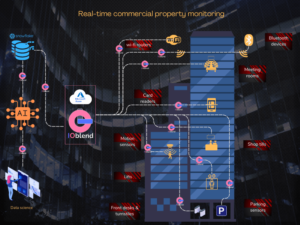Use Case
IOblend is gaining popularity in the murky world of data integration. From automating real-time factory data collection to ERP data synchronisation to multi-system integrations, IOblend covers a wide variety of use cases. Customers and implementation partners are discovering how our new technology can help them improve delivery timescales, lower implementation costs and increase project ROI. Let’s see the latest project made successful with IOblend.
Background
The client needed to make data from their main operational system available for immediate consumption by five downstream processes. The existing solution in place was costly to manage (several intermediate staging steps), required frequent manual interventions and did not support real-time processing (micro-batch only).
The challenge was to transform data into a common standard. It needed to be validated for quality and completeness. The solution had to be able to account for source system disruptions. In addition, the solution had to provide the full lineage for each data record to comply with strict audit requirements.
The infrastructure was already in place, so the key constraint was to make the solution compatible with AWS.
After a thorough market study, the client selected IOblend due to performance, flexibility, ease of use, and fast development time.
Objectives
The primary objectives for selecting IOblend were:
- Integration: The tool needed to integrate smoothly with the client’s existing AWS The client wanted to minimise disruption to the exiting integration process and downstream consumers.
- Manageability: The solution had to be easy to deploy, control, and configure within the client’s secure cloud environment.
- Flexibility: The solution had to be able to accommodate complex transformation logic, format changes, and stored procedures. Real-time processing was essential.
- Usability: The solution had to have a minimal learning curve, enabling quick setup and use by existing developers.
Implementation
IOblend connected to the Ops system via an existing API. It replaced the AWS Glue batch (times polling) ingest with real-time, event-driven mechanism.
The next step was to transform data formats into an agreed standard. The existing architecture required a staging layer within AWS to convert the formats. IOblend performs such steps in memory, while the data is in-transit, thus reducing latency and removing a staging layer. The fetched data was transformed using custom Python scripts to fit the required formats of the analytical processes.
Data quality rules were also inserted into the pipeline based on acceptable thresholds. IOblend sends alerts to the developers and separates non-conforming data into a standalone table for completeness.
The transformed, curated data was deposited in AWS Kinesis Stream, acting as a queue for onward real-time and on-demand consumption. No further post-processing is required and no additional ETL or management technologies were used.
The pipeline was deployed on client’s AWS EMR cluster. IOblend automatically optimises and manages Spark compute.
IOblend was run in parallel with the existing process until the QA sign off. At which point IOblend seamlessly took over without any disruption to the downstream consumers.

Benefits
The integration of IOblend provided several benefits:
- Enhanced data processing: Enabled complex data transformations with minimal effort in real-time.
- Scalability: Automatically scalable to handle increased data volumes.
- Security: Ensured data security by operating within the client’s strictly controlled AWS environment.
- Flexibility: Effortlessly supported multiple data formats and transformation techniques using Python and SQL.
- Data quality: Enabled automated data curation, lineage, CDC, eventing, regressions, alerting and full logging.
- Cost-reduction: Removed the need for a data staging layer, minimised maintenance effort through automation and reduced ASW compute costs.
- Fast deployment: The pipeline went in-prod within five days from the project start, massively reducing development time and cost. The project was delivered by a single developer who has never worked with IOblend prior.
Conclusion
We believe in simplicity and versatility of data integration tools. This is why we created a “Swiss army knife” solution to allow you to perform production-grade data integration tasks with IOblend in a simple way. It can work with any infrastructure, existing business processes, security protocols and developer resources.
With IOblend, you will drastically reduce the cost of production data pipeline development, simplify your architecture and integrate any data securely across all systems.
This is what the data developer has said about IOblend in this project: “The adoption of IOblend significantly improved our data transformation capabilities, allowing for efficient and secure data integration between multiple systems. The flexible and user-friendly nature of IOblend facilitated rapid deployment and ease of management, meeting all the outlined objectives effectively.”
If you want to learn how IOblend can help you with data integration challenges, reach out to us. We can help you reduce cost and accelerate delivery of your data migrations, system synchronisations, IoT and real-time analytics, CRM and ERP integrations, plus lots more.
IOblend presents a ground-breaking approach to IoT and data integration, revolutionizing the way businesses handle their data. It’s an all-in-one data integration accelerator, boasting real-time, production-grade, managed Apache Spark™ data pipelines that can be set up in mere minutes. This facilitates a massive acceleration in data migration projects, whether from on-prem to cloud or between clouds, thanks to its low code/no code development and automated data management and governance.
IOblend also simplifies the integration of streaming and batch data through Kappa architecture, significantly boosting the efficiency of operational analytics and MLOps. Its system enables the robust and cost-effective delivery of both centralized and federated data architectures, with low latency and massively parallelized data processing, capable of handling over 10 million transactions per second. Additionally, IOblend integrates seamlessly with leading cloud services like Snowflake and Microsoft Azure, underscoring its versatility and broad applicability in various data environments.
At its core, IOblend is an end-to-end enterprise data integration solution built with DataOps capability. It stands out as a versatile ETL product for building and managing data estates with high-grade data flows. The platform powers operational analytics and AI initiatives, drastically reducing the costs and development efforts associated with data projects and data science ventures. It’s engineered to connect to any source, perform in-memory transformations of streaming and batch data, and direct the results to any destination with minimal effort.
IOblend’s use cases are diverse and impactful. It streams live data from factories to automated forecasting models and channels data from IoT sensors to real-time monitoring applications, enabling automated decision-making based on live inputs and historical statistics. Additionally, it handles the movement of production-grade streaming and batch data to and from cloud data warehouses and lakes, powers data exchanges, and feeds applications with data that adheres to complex business rules and governance policies.
The platform comprises two core components: the IOblend Designer and the IOblend Engine. The IOblend Designer is a desktop GUI used for designing, building, and testing data pipeline DAGs, producing metadata that describes the data pipelines. The IOblend Engine, the heart of the system, converts this metadata into Spark streaming jobs executed on any Spark cluster. Available in Developer and Enterprise suites, IOblend supports both local and remote engine operations, catering to a wide range of development and operational needs. It also facilitates collaborative development and pipeline versioning, making it a robust tool for modern data management and analytics

Change Data Capture: IOblend’s Seamless Approach
Change Data Capture In the fast-paced world of data management, staying ahead of the curve is not an option, it’s a necessity. Change Data Capture (CDC) is the secret weapon that allows businesses to keep pace with the constant flux of data. In this blog, we will delve into the world of CDC, explore different


Data Schema Management with IOblend
Data Schema Management In today’s data-driven world, managing data effectively is crucial for businesses seeking to gain insights and make informed decisions. Data schema management is a fundamental aspect of this process, ensuring that data is organized, structured, and compatible with various applications and systems. In this blog post, we’ll explore the significance of data


Smarter office management with real-time analytics
Commercial property Welcome to the next issue of our real-time analytics blog. This time we are taking a detour from the aviation analytics to the world of commercial property management. The topic arose from a use case we are working on now at IOblend. It just shows how broad a scope is for real-time data


Better airport operations with real-time analytics
Good and bad Welcome to the next issue of our real-time analytics blog. Now that the summer holiday season is upon us, many of us will be using air travel to get to their destinations of choice. This means, we will be going through the airports. As passengers, we have love-hate relationships with airports. Some


The making of a commercial flight
What makes a flight Welcome to the next leg of our airline data blog journey. In this article, we will be looking at what happens behind the scenes to make a single commercial flight, well, take flight. We will again consider how processes and data come together in (somewhat of a) harmony to bring your


Enhance your airline’s analytics with a data mesh
Building a flying program In the last blog, I have covered how airlines plan their route networks using various strategies, data sources and analytical tools. Today, we will be covering how the network plan comes to life. Once the plans are developed, they are handed over to “production”. Putting a network plan into production is


Planning an airline’s route network with deep data insights
What makes an airline Commercial airlines are complex beasts. They comprise of multiple intertwined (and siloed!) functions that make the business work. As passengers, we see a “tip of the iceberg” when we fly. A lot of work goes into making that flight happen, which starts well in advance. Let’s distil the complexity into something


Flying smarter with real-time analytics
Dynamic decisioning We continue exploring the topics of operational analytics (OA) in the aviation industry. Data plays a crucial role in flight performance analytics, operational decisioning and risk management. Real-time data enhances them. The aviation industry uses real-time data for a multitude of operational analytics cases: monitor operational systems, measure wear and tear of equipment,


How Operational Analytics power Ground Handling
The Ground Handling journey – today and tomorrow In today’s blog we are discussing how Operational Analytics (OA) enables the aviation Ground Handling industry to deliver their services to airlines. Aviation is one of the most complex industries out there, so it offers a wealth of examples (plus it’s also close to our hearts). OA


Airline safety management: enhance your SMS with IOblend
Today we are looking at the data aspect of flight safety management in the aviation industry.


Unlock new capabilities with real time ACARS data
In this short article we are looking at one of the key data sources for the aviation industry – ACARS – and how IOblend helps to unlock new analytical capabilities from it.


Time to automate your airline’s DOC data
How to automate Direct Operating Cost (DOC) data collection, processing and serving with IOblend.

